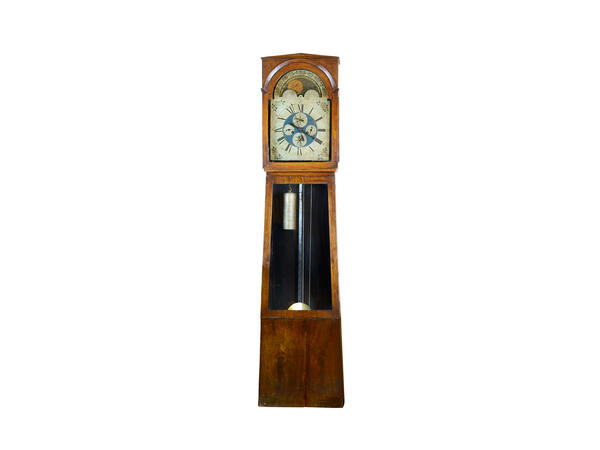The exhibition features an interior clock with a pendulum mechanism. They are placed in a tall case decorated with walnut wood veneer. The clock came to the museum from the house of the Murom merchants’s family, the Kiselevs.
Prototypes of “tall-case clocks” were known way back in the late Middle Ages. In the early 16th century, the Nuremberg watchmaker Peter Henlein invented a winding mainspring, creating then a portable clock on its basis. This model showed the time with only one hand. The craftsman put it in an oval case made of gilded brass. This kind of clock was carried in a pocket and was called the “Nuremberg egg”.
In 1657, the Dutch mechanic and inventor Christiaan Huygens used a pendulum in clocks for the first time. Based on Huygens’ design, wall and floor pendulum clocks were created.
The height of such cases depended on the size of the mechanism. Originally, the clocks were equipped with a crown escapement: a special built-in spring rotated, switching pins attached to it, and they rocked the pendulum. The movement of the pendulum, in turn, returned the pins to their original position, and the hand moved. But due to the large amplitude of the swing, this design did not make it possible to use a long pendulum.
In 1670, an anchor escapement mechanism was invented, and they started to use minute pendulums. A special weight was suspended on a rope, which set in motion the wheels of the mechanism and started the clock. The movement reached the brake wheel, which interacted with a special attachment — an anchor — and the mechanism rotated. The pendulum served as a regulator: it changed the position of the anchor, which released the brake pinion. When the pendulum made the opposite movement, a cog of the brake wheel would press on the anchor and transmit the force to the pendulum again. Thus, the brake wheel moved in time with the swing of the pendulum.
With the advent of the anchor mechanism, the amplitude of the pendulum’s swing decreased and the pendulum itself became longer. They began to produce elongated vertical cabinets for such pendulums.
In the second half of the 18th century, a second hand appeared on the dial of most floor clocks. This improved the accuracy of the clock.
On the dial of the clock craftsmen could add additional scales for switching on and off the mechanism of striking, selecting the musical composition of the striking, calendar and astronomical dials. There are four such scales in the clock from the museum’s collection: the seconds scale, the minutes scale, the chime scale, and the solar calendar scale.
Prototypes of “tall-case clocks” were known way back in the late Middle Ages. In the early 16th century, the Nuremberg watchmaker Peter Henlein invented a winding mainspring, creating then a portable clock on its basis. This model showed the time with only one hand. The craftsman put it in an oval case made of gilded brass. This kind of clock was carried in a pocket and was called the “Nuremberg egg”.
In 1657, the Dutch mechanic and inventor Christiaan Huygens used a pendulum in clocks for the first time. Based on Huygens’ design, wall and floor pendulum clocks were created.
The height of such cases depended on the size of the mechanism. Originally, the clocks were equipped with a crown escapement: a special built-in spring rotated, switching pins attached to it, and they rocked the pendulum. The movement of the pendulum, in turn, returned the pins to their original position, and the hand moved. But due to the large amplitude of the swing, this design did not make it possible to use a long pendulum.
In 1670, an anchor escapement mechanism was invented, and they started to use minute pendulums. A special weight was suspended on a rope, which set in motion the wheels of the mechanism and started the clock. The movement reached the brake wheel, which interacted with a special attachment — an anchor — and the mechanism rotated. The pendulum served as a regulator: it changed the position of the anchor, which released the brake pinion. When the pendulum made the opposite movement, a cog of the brake wheel would press on the anchor and transmit the force to the pendulum again. Thus, the brake wheel moved in time with the swing of the pendulum.
With the advent of the anchor mechanism, the amplitude of the pendulum’s swing decreased and the pendulum itself became longer. They began to produce elongated vertical cabinets for such pendulums.
In the second half of the 18th century, a second hand appeared on the dial of most floor clocks. This improved the accuracy of the clock.
On the dial of the clock craftsmen could add additional scales for switching on and off the mechanism of striking, selecting the musical composition of the striking, calendar and astronomical dials. There are four such scales in the clock from the museum’s collection: the seconds scale, the minutes scale, the chime scale, and the solar calendar scale.



